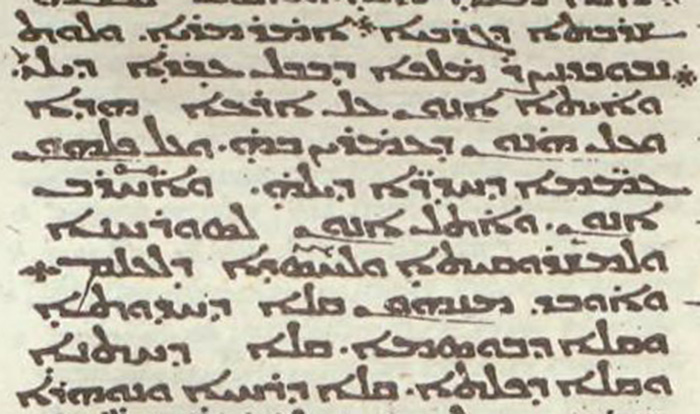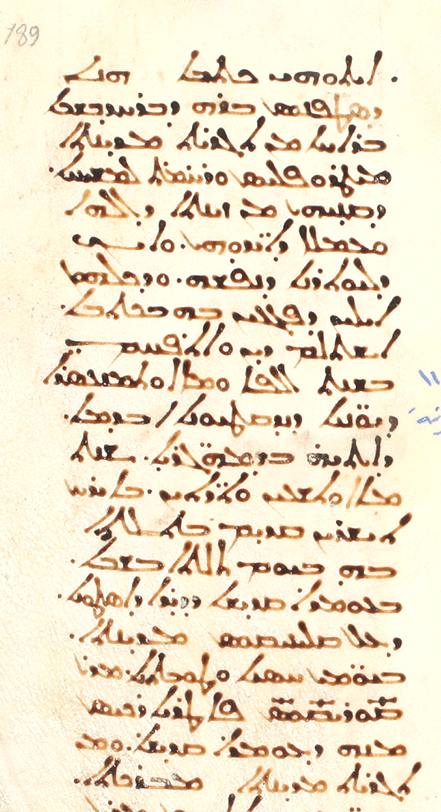Lesson
Syriac Scripts - Usual Estrangela

Description
A “standard” form of Estrangela that begins to show the variations often characterized as “Serto” script.
Example 1
Jerusalem, SMMJ 180, ff. 54v-55r (7th/8th C.)
The examples highlighted in this lesson come mainly from the 8th-11th centuries. I am calling it “usual” Estrangela because the common type of writing in these examples aligns closely with what people will consider a classic or typical kind of Estrangela, although even here there are also examples of certain shapes more often associated with Serto, and, as usual, in any case, every manuscript shows some peculiarities.
Specific features are indicated below generally only when distinct from those mentioned for DIYR 339 in the lesson on Earliest Estrangela.
Book of Steps
Jerusalem, Saint Mark's Monastery, SMMJ 180, ff. 54v-55r. All rights reserved. Image provided by HMML.
| ālap | usually relatively short if the following letter has a leading line it may be attached to the ālap, as in the first word (wp’š) of f. 55r, col. a, line 17 |
| bēt | has a relatively narrow top horizontal |
| dālat / rēš | angled, with a thicker top line that is not as long as the vertical line |
| wāw | not closed, and the vertical line on the right hangs a little below the line |
| lāmad | reaches very high, sometimes crossing the line above |
| mim | not closed |
| nun | in its final form not attached to the previous letter is at an angle noticeably more horizontal than when it is attached |
| semkat | not attached |
| šin | the shape of a small t |
This manuscript is an early copy of the Book of Steps (Liber graduum) and parts of the Asceticon of Abba Isaiah. The original order of folios has been obliterated by misbinding, and thus the present arrangement is wholly confused. As in SMMJ 129, some notes in early Serto complement the Estrangela of the main text.
The script is very straightforward Estrangela, with sharp angles as in the bēt and ṭēt. When there is a little space at line end, the final letter has an extender to reach the edge. Here are some remarks on a few particulars:
Example 2
Jerusalem, SMMJ 1, ff. 47v-48r (8th C.?)
Hexaplaric signs are found throughout. As for word-spacing, n.b. w-meṭṭol-hādē written without spaces in f. 48/p. 73, line 2.
Isaiah (Syro-Hexapla)
Jerusalem, Saint Mark's Monastery, SMMJ 1, ff. 47v-48r (pp. 92-93). All rights reserved. Image provided by HMML.
| ālap | top part curves upward, ending with a thicker topmost part |
| gāmal | when joined on the right, the right side is not straight (see f. 38r/p. 73, line 10) |
| dālat / rēš | sharp right angle vertical and horizontal parts about the same size |
| zayn | does not hang below line |
| yod | final form in the shape of a comma |
| kāp | top may be flatter or more curved (examples of both on f. 37v/p. 72, line 16) in final form descender very thin |
| mim | open loop final form has very thin descender |
| semkat | not attached left loop notably taller than the right, and of a distinctly different shape |
| ṣādē | descender very thin |
| šin | bowl shape at top, but relatively wide |
Example 3
London, BL Add. 14532, f. 194r (8th C.)
Thick lines of relative uniformity.
Excerpts from the Fathers Against Heresies
© The British Library Board, Add. 14532, f. 194r.
| ālap | serif on top, as well as on the bottom of the right leg |
| gāmal | very small dot at the lowest point of the letter |
| dālat / rēš | the top bar is short, often joined to the vertical by not much of an angle |
| wāw | angled at top right, then round on the left loop usually open |
| yod | joined form often rather tall, but not quite as tall as nun final isolated form is the comma shape |
| mim | loop sometimes open, sometimes closed |
| semkat | not attached left loop notably taller than the right, and of a distinctly different shape |
| ṣādē | descender very thin, esp. in comparison to the uniform thickness elsewhere in the script |
| šin | thick bowl or chalice shape |
Example 4
Mardin, CFMM 309, p. 112 (8th/9th C.)
This manuscript, some pages of which are more difficult to read due to faded ink, has its main text in Estrangela, but the scribe himself (it seems) has also made several marginal notes in Serto (longer ones on pp. 313 and 321, for example). Several pages, including this one, also have some Greek names either in the margin or in a separate column.
The abbreviations are marked, as usual, with an overline, in this case with small dots at each end.
Canons
© Mardin, Church of the Forty Martyrs, CFMM 309, p. 112. All rights reserved. Image provided by HMML.
| ālap | very wide, with a large dot or serif at the top the left leg sometimes hangs especially low |
| dālat and rēš | of a very compact, slightly rounded Serto type, hanging below the line only barely, if at all |
| hē | of the Serto type, with a closed loop |
| wāw | completely round, as in Serto |
| nun | in isolated form merely a thick dot with a very thin angled descender |
| semkat | of the left-leaning θ shape |
| šin | very squat and thick, with no separate top part |
| tāw | has a loop so tightly closed that it is nonexistent |
Example 5 - Three 8th/9th century manuscripts
Milan, Cod. Ambr. A (C313 Inf.; 8th/9th C.), f. 126ra
Syro-Hexapla
A legible facsimile of Cod. Ambr. A is available here. This manuscript has overall a sharper, more angular ductus than the fifth century manuscripts, and with a shorter line height.
Codex Syro-hexaplaris Ambrosianus, f. 126r, with Jer 25:9-10 (static non-zoomable image)
 Milan, Cod. Ambr. A, f. 126ra, ll. 24-33.
Milan, Cod. Ambr. A, f. 126ra, ll. 24-33.
Note the hexaplaric signs inherited from Origen (and in turn, from Alexandrian Homeric scholarship) to indicate pluses, minuses and other textual relationships between the Hebrew text and the translated, and thus here the Syriac text based on the Greek (see further B.M. Metzger, Manuscripts of the Greek Bible, § 22).
| ālap | when connected and not, there is a serif on the right leg left leg sits a little below the line top part may have upward turn height of top part varies |
| gāmal | ends well below line, but without the thick dot of some later examples |
| dālat / rēš | angled, more usual Estrangela form |
| hē | center post relatively straight, not angling to the left much |
| wāw | more sharp than round on right side unclosed loop |
| ḥēt | often about the same height as yod, but sometimes higher |
| yod | final, unconnected form with left extender (esp. at line end), or of the angled type final, connected form of the angled type |
| kāp | somewhat round on top, but without a high point: i.e. relatively straight on top final form with relatively short tail |
| lāmad | notably thicker at the top |
| mim | loop open more sharp than round on the right |
| semkat | somewhat pointed loops (esp. left), left one taller does not join following letter |
| ʿē | may have relatively narrow angle between top and lower part |
| qop | relatively angular on all sides final form with small tail on left |
| šin | very thick horizontal base round bowl shape on top |
| tāw | loop open |
Jerusalem, SMMJ 129, pp. 120-121 (dated 806)
Quriaqos of Tagrit
The bulk of the manuscript is devoted to theological treatises of Quriaqos of Tagrit, in whose lifetime this manuscript was copied. The main text is in Estrangela, while the colophon is in Serto.
Part of the Serto colophon (dated Oct. 3, 806) -- static non-zoomable image
 Column from Jerusalem, Saint Mark's Monastery, SMMJ 129, p. 189. All rights reserved. Image provided by HMML.
Column from Jerusalem, Saint Mark's Monastery, SMMJ 129, p. 189. All rights reserved. Image provided by HMML.
Jerusalem, Saint Mark's Monastery, SMMJ 129, pp. 120-121. All rights reserved. Image provided by HMML.
| ālap | has a conspicuous curve upward at the top, but usually with not much of a dot or serif at the end |
| bēt | has a notable short top line |
| gāmal | ends in a dot |
| dālat / rēš | angled, with a thicker top line that is not as long as the vertical line |
| wāw | sharp on the right and has an open loop |
| mim | sharp on the right, with an open loop, and the top part curving upward on the left |
| semkat | has a much higher and separately formed left loop |
| ʿē | has a dot on the far right |
The Estrangela script here is rather angular and makes a careful, stately impression.
Vatican City, Vat. Sir. 161, f. 113v (9th C.)
Acts of the Persian Martyrs
© Bibliotheca Apostolica Vaticana, Sir. 161, f. 113v.
| dālat / rēš | Serto shape |
| hē | Serto shape, with closed loop on the left |
| wāw | may have an angle on the top right or be curved loop generally open, but may be closed |
| zayn | does not hang below lines thicker at the top |
| yod | joined form often rather tall, but not quite as tall as nun final isolated form is the comma shape |
| kāp | final form more jagged than curved |
| mim | loop closed top part curves upward |
| semkat | joins with following letter both loops about the same size |
| tāw | either with very tight loop, essentially closed, or the more common Estrangela type |
Example 6
Vatican City, Vat. Sir. 118, f. 40v (pre-12th C.)
Jacob of Serugh, Memre
© Bibliotheca Apostolica Vaticana, Sir. 118, f. 40v.
| ālap | top part, ending in a dot, much thinner than the bottom part |
| gāmal | very thick dot at the bottom the top arm has a narrowed middle |
| dālat / rēš | Serto shape, with a very thick dot as the topmost part |
| hē | Serto shape, with closed loop on left |
| wāw | a perfect o shape |
| zayn | does not hang below line |
| ṭēt | the top and bottom parts are each the same height |
| yod | very short |
| mim | top line angles upward closed loop |
| semkat | left loop only very slightly taller than the right neither loop pointed |
| ʿē | the top arm has a narrowed middle |
| pē | rather tall |
| ṣādē | thin descender |
| šin | top part essentially a flat line |
| tāw | closed loop |
The script here has a very thick, sharp character.
Ready to transcribe?
Try your hand at transcribing Usual Estrangela scripts